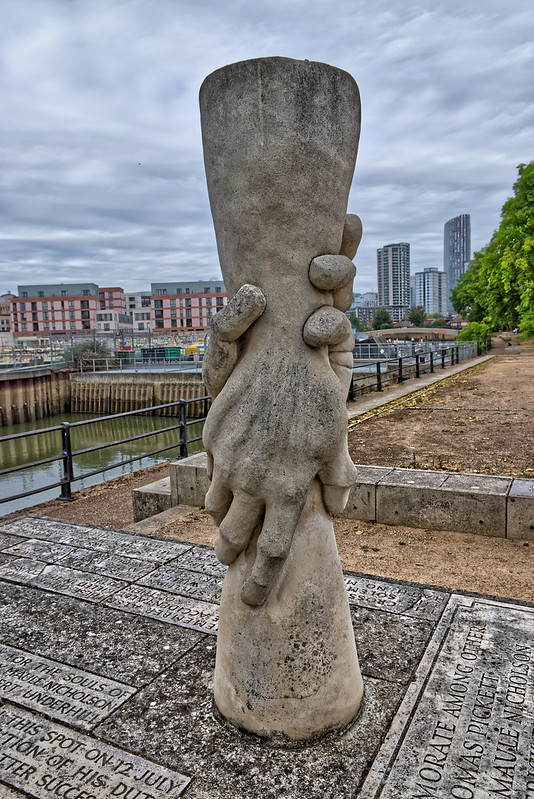Archive for the ‘Trust’ Category
How I Develop Engineering Leaders
 For the past two decades, I’ve actively developed engineering leaders. A good friend asked me how I do it, so I took some time to write it down. Here is the curriculum in the form of How Tos:
For the past two decades, I’ve actively developed engineering leaders. A good friend asked me how I do it, so I took some time to write it down. Here is the curriculum in the form of How Tos:
How to build trust. This is the first thing. Always. Done right, the trust-based informal networks are stronger than the formal organization chart. Done right, the informal networks can protect the company from bad decisions. Done right, the right information flows among the right engineers at the right time so the right work happens in the right way.
How to decide what to do next. This is a broad one. We start with a series of questions: What are we doing now? What’s the problem? How do you know? What should we do more of? What should we do less of? What resources are available? When must we be done?
How to map the current state. We don’t define the idealized future state or the North Star, we start with what’s happening now. We make one-page maps of the territory. We use drawings, flow charts, boxes/arrows, and the fewest words. And we take no action before there’s agreement on how things are. The value of GPS isn’t to define your destination, it’s to establish your location. That’s why we map the current state.
How to build momentum. It’s easy to jump onto a moving steam train, but a stationary one is difficult to get moving. We define the active projects and ask – How might we hitch our wagon to a fast-moving train?
How to start something new. We start small and make a thought-provoking demo. The prototype forces us to think through all the elements, makes things real, and helps others understand the concept. If that doesn’t work, we start smaller.
How to define problems so we can solve them easily. We define problems with blocks and arrows, and limit ourselves to one page. The problem is defined as a region of contact between two things, and we identify it with the color red. That helps us know where the problem is and when it occurs. If there are two problems on a page, we break it up into two pages with one problem. Then we decide to solve the problem before, during, or after it occurs.
How to design products that work better and cost less. We create Pareto charts of the cost of the existing product (cost by subassembly and cost by part) and set a cost reduction goal. We create Pareto charts of the part count of the existing product (part count by subassembly and part count by individual part number) and define a goal for part count reduction. We define test protocols that capture the functionality customers care about. We test the existing product and set performance improvement goals for the new one. We test the new product using the same protocols and show the data in a simple A-B format. We present all this data at formal design reviews.
How to define technology projects. We define how the customer does their work. We then define the evolutionary history of our products and services, and project that history forward. For lines of goodness with trajectories that predict improvement, we run projects to improve them. For lines of goodness with stalled trajectories, we run projects to establish new technologies and jump to the next S-curve. We assess our offerings for completeness and create technologies to fill the gap.
How to file the right patents. We ask these questions: How quickly will the customer notice the new functionality or benefit? Once recognized, will they care? Will the patent protect high-volume / high-margin consumables? There are more questions, but these are the ones we start with. And the patent team is an integral part of the technology reviews and product development process.
How to do the learning. We start with the leader’s existing goals and deliverables and identify the necessary How Tos to get their work done. There are no special projects or extra work.
If you’re interested in learning more about the curriculum or how to enroll, send me an email mike@shipulski.com.
Image credit — Paul VanDerWerf
Making a difference starts with recognizing the opportunity to make one.
 It doesn’t take much to make a difference, but if you don’t recognize the need to make one, you won’t make one.
It doesn’t take much to make a difference, but if you don’t recognize the need to make one, you won’t make one.
When you’re in a meeting, watch and listen. If someone is quiet, ask them a question. My favorite is “What do you think?” Your question says you value them and their thinking, and that makes a difference. Others will recognize the difference you made, and that may inspire them to make a similar difference at their next meeting.
When you see a friend in the hallway, look them in the eyes, smile, and ask them what they’re up to. Listen to their words but more importantly watch their body language. If you recognize they are energetic, acknowledge their energy, ask what’s fueling them, and listen. Ask more questions to let them know you care. That will make a difference. If you recognize they have low energy, tell them, and then ask what that’s all about. Try to understand what’s going on for them. You don’t have to fix anything to make a difference, you have to invest in the conversation. They’ll recognize your genuine interest and that will make a difference.
If you remember someone is going through something, send them a simple text – “I’m thinking of you.” That’s it. Just say that. They’ll know you remembered their situation and that you care. And that will make a difference. Again, you don’t have to fix anything. You just have to send the text.
Check in with a friend. That will make a difference.
When you learn someone got a promotion, send them a quick note. Sooner is better, but either way, you’ll make a difference.
Ask someone if they need help. Even if they say no, you’ve made a difference. And if they say yes, help them. That will make a big difference.
And here’s a little different spin. If you need help, ask for it. Tell them why you need it and explain why you asked them. You’ll demonstrate vulnerability and they’ll recognize you trust them. Difference made. And your request for help will signal that you think they’re capable and caring. Another difference made.
It doesn’t take much to make a difference. Pay attention and take action and you’ll make a difference. But really, you’ll make two differences. You’ll make a difference for them and you’ll make a difference for yourself.
Image credit — Geoff Henson
Happy, Lonely, Sad, Angry
 Happy – when you can bring your whole self to everything you do.
Happy – when you can bring your whole self to everything you do.
Lonely – when you’re with people all day but can’t be truthful with them.
Sad – when you see what could be but never will.
Angry – when someone is less than truthful.
Happy – when people you care about are treated well.
Lonely – when you’re misunderstood.
Sad – when you realize a person’s lack of truthfulness will make them lonely.
Angry – when you take things personally that aren’t personal.
Happy – when an old friend visits.
Lonely – when there’s no trust.
Sad – when you see someone break trust and you know that will bring them loneliness.
Angry – when you know someone should know better.
Happy – when someone asks you for help.
Lonely – when you know you can help but they don’t ask.
Sad – when someone is set up for failure and there’s no way to help them.
Angry – when that someone is a good friend.
Happy – when you have your health.
Happy – when you have fun with friends.
Happy – when you spend time outside.
Happy – when you walk your dogs.
Happy – when your kids and your partner love you.
Whether you’re happy, lonely, sad, or angry, this too shall pass.
Image credit – Tambako the Jaguar.
Holidays are special because family is special.
 Holidays aren’t about shopping, gifts, special dinners, or travel. Holidays are about family.
Holidays aren’t about shopping, gifts, special dinners, or travel. Holidays are about family.
On holidays, people travel. They don’t travel to tourist sites, national parks, or big cities for big cities’ stake. People travel to see their families.
On holidays, people eat special foods prepared in special ways and served on special plates. But that’s not special. Family prepares the food, family sits at the table, and family eats the food. What’s special is family.
Oh holidays, people tell the same stories of old shared experiences. Everyone knows all the stories, but they’re still told every year. Sure, the stories are misremembered, but the storyline holds. The family’s shared experiences are reexperienced and relationships deepen. Family is special because it helps us remember and grounds us.
On holidays, people don’t always get along. Some of the same arguments arise and some new ones are born. Tempers flare and then cool. Because of the significant body of shared experiences and shared memories, there are more opportunities to disagree. And because family creates a safe space, sharing strong feelings is okay. It’s easy to see (and hear) the arguments and it isn’t easy to see what makes them possible – shared context, shared memories, and a safe space built on trust. Without these regular arguments cannot rise to the level of family arguments. Family arguments are a higher genus of arguments; they are noble arguments. Family arguments can realized only by families.
I hope you can spend the holidays with your family. If not, I hope you can have a great video call with them, have a meaningful phone call with them, or even a funny text exchange. And if you can’t, I hope you can spend time with good friends who are like family.
Image credit – Craig Sefton
What do you choose to be?

Be bold – the alternative is boring.
Be the first to forgive – it’s like forgiving twice.
Be yourself – you’re the best at that.
Be afraid – and do it anyway.
Be effective – and to hell with efficiency.
Be happy – if that’s what’s inside.
Be authentic – it’s invigorating.
Be energetic – it’s contagious.
Be a listener – that’s where learning comes from.
Be on time – it says you care.
Be early if you can’t be on time – but just a little.
Be courageous – but sparingly.
Be kind – people remember.
Be truthful – that’s how trust is built.
Be a learner – by learning to listen.
Be sad – if that’s what’s inside.
Be a friend – it’s good for them and better for you.
Be nobody – it’s better for everybody, even you.
Image credit — Irene Steeves
When The Same Old Tricks Don’t Work
 Here’s what it looks like when the same old tricks no longer carry the day.
Here’s what it looks like when the same old tricks no longer carry the day.
Efficiency of effort
- For the same energy, you get more in return.
- For the same energy, you get the same in return.
- For more energy, you get the same in return.
- For more energy, you get less in return.
- Out of energy.
Efficiency of profit
- Increased profit and increased sales.
- Lesser increased profit and unchanged sales.
- Unchanged profit and unchanged sales.
- Decreased profit and unchanged sales.
- Decreased profit and decreased sales.
- No profit and no sales.
Vibrancy
- High-energy citizens with a strong customer focus.
- Medium energy team members with some customer focus.
- Medium-energy people with little customer focus.
- Lethargic nameless humans with no customer focus.
- Nobody home.
Time Horizon
- Long-term purpose, medium-term execution, short-term adaptation.
- Medium-term execution, short-term adaptation.
- Short-term execution, shorter-term bickering.
- Shortest-term floundering.
- Out of time.
Truthfulness
- Truthful communication is delivered clearly and skillfully.
- Truthful communication is delivered less skillfully.
- Partial truths delivered.
- Partial truths delivered unskillfully.
- No truths.
Trust
- Many tight groups of informal networks share information naturally and effectively.
- Informal networks share information naturally.
- Informal networks share information.
- Informal networks go underground to share information.
- Informal networks go underground and band together to protect each other.
- Informal networks give up.
Image credit — philhearing
It’s not the work, it’s the people.
 I used to think the work was most important. Now I think it’s the people you work with.
I used to think the work was most important. Now I think it’s the people you work with.
Hard work is hard, but not when you share it with people you care about.
Struggle is tolerable when you’re elbow-to-elbow with people you trust.
Fear is manageable when you have faith in your crew.
You’re happy to carry an extra load when your friend needs the help.
And your friend is happy to do the same for you.
When you’ve been through the wringer a teammate, they grow into more than a teammate.
If you smile at work, it’s likely because of the people you work with.
And when you’re sad at work, it’s also likely because of to the people.
When you care about each other, things get easier, even when they’re not easy.
Stop what you’re doing and look at the people around you.
What do you see?
Who has helped you? Who has asked for help?
Who has confided in you? To whom have you confided?
Who believes in you? In whom do you believe?
Who are you happy to see? Who are you not?
Who will you miss when they’re gone?
For the most important people, take a minute and write down your shared experiences and what they mean to you.
What would it mean to them if you shared your thoughts and feelings?
Why not take a minute and find out?
Wouldn’t work be more energizing and fun?
If you agree, why not do it? What’s in the way? What’s stopping you?
Why not push through the discomfort and take things to the next level?
Image credit — HLI-Photography
When I’m Asked To Take On New Work
 Here are the questions I ask myself when I’m asked to take on new work….
Here are the questions I ask myself when I’m asked to take on new work….
Do I know what the work is all about?
Is it well-defined?
Would it make a big difference if the work is completed successfully?
Would it make a big difference if it’s not?
Is it clear how to judge if the work is completed successfully?
Is the work important and how do I know?
Is it urgent? (The previous question is far more important to me.)
Is there more important work?
Who would benefit from the work and how do I feel about it?
Would I benefit and how do I feel about it?
Am I uniquely qualified or can others do the work?
Am I interested in the work?
Would I grow from the work?
Who would I work for?
Who would I work with?
Would my career progress?
Would I get a raise?
Would I spend more time with my family?
Would I spend more time in meetings?
Would I travel more?
What does my Trust Network think?
Would I have fun? (I think this is a powerful question.)
These aren’t the questions you should ask yourself, but I hope the list helps you develop your own.
Image credit — broombesoom
It’s time to turn something that isn’t into something that is.

It’s not possible until you demonstrate it.
It can’t be done until you show it being done.
It won’t work until you make it work.
It must be done using the standard process until you do it a much better way.
It’s required until you violate the requirement and everything is fine.
It’s needed until you show people how to do without.
It’s no one’s responsibility until you take responsibility and do it yourself.
It’s not fun until you have fun doing it.
It’s not sanctioned until you create something magical in an unsanctioned way.
It’s a crappy assignment until you transform it into a meaningful assignment.
It’s a lonely place until you help someone do their work better.
It’s a low-trust place until you trust someone.
It’s scary until you do it anyway.
So do it anyway.
Image credit — Tambako The Jaguar
How To Be More Effective

Put it out there. You don’t have time to do otherwise.
Be true to yourself. No one deserves that more than you do.
Tell the truth, even when it’s difficult for people to hear. They’ll appreciate your honesty.
Believe the actions and not the words. Enough said.
Learn to listen to what is not said. That’s usually the juicy part.
Say no to good projects so you can say yes to great ones.
Say what you will do and do it. That’s where trust comes from.
Deliver praise in public. Better yet, deliver praise in front of their spouse.
Develop informal networks. They are more powerful than the formal org chart.
Learn to see what’s not happening. You’ll understand what’s truly going on.
Help people. It’s like helping yourself twice.
Don’t start a project you’re not committed to finishing. There’s no partial credit with projects.
Do the right thing, even if it comes at your expense.
And be your best self. Isn’t that what you do best?
Image credit — Tambako The Jaguar
Why not be yourself?
 Be successful, but be yourself.
Be successful, but be yourself.
Accept people for who they are and everything else gets better.
Tell the truth, even if it causes stress. In the short term, it is emotionally challenging but in the long term, it builds trust.
Disagree, yes. Disappoint, yes. Disavow, no.
Be effective, but be yourself.
If your actions cause pain, apologize. It’s that simple.
It’s easier to accept others as they are when you can do the same for yourself.
Judging yourself is the opposite of accepting yourself as you are.
When someone needs help, help them.
Be skillful, but be yourself.
If there’s an upside to judging yourself, I don’t know it.
When you’re true to yourself, people can disagree with your position but not your truthfulness.
When you help someone, it’s like helping yourself twice.
There are plenty of people who will judge you. There’s no need to join that club.
When you stand firmly on emotional bedrock, your perspective is unassailable.
When you’re true to yourself, it’s easier for others to do the same.
Be yourself especially when it’s difficult. Your courage will empower others.
If there’s no upside to judging yourself, why do it?
Some questions for you:
How would things be different if you stopped judging yourself? Why not give it a try tomorrow?
Wouldn’t you like to be unassailable? Why not stand on your emotional bedrock tomorrow?
Over the next week, how many people will you help?
Over the next week, how many times will you demonstrate courage?
Over the next week, how many times will you be true to yourself, even when it’s difficult?
Image credit – _Veit_
 Mike Shipulski
Mike Shipulski